Assignment 4: Resilience and the Community - PSYC 3991
VerifiedAdded on 2023/04/21
|7
|2197
|335
Homework Assignment
AI Summary
This assignment delves into the psychology of resilience, examining various aspects of community and individual well-being. The solution addresses questions related to the "Big Brothers/Big Sisters" mentoring program, exploring the impact on minority youth and drug use. It also analyzes the influence of factors like IQ and physical attractiveness on peer relationships, and their protective effects against family risk factors. Furthermore, the assignment explores the relationship between peer support and internalizing behaviors, as well as methodological challenges in homework assistance programs. The research of Michael Chandler on cultural awareness and Aboriginal youth is discussed, along with the role of social support in recovery. Finally, it includes an essay defining academic resilience and its connection to academic performance, highlighting factors like belonging, mastery, independence, and generosity, along with the importance of social support, curriculum, teachers, and parental involvement in fostering resilience among at-risk students.
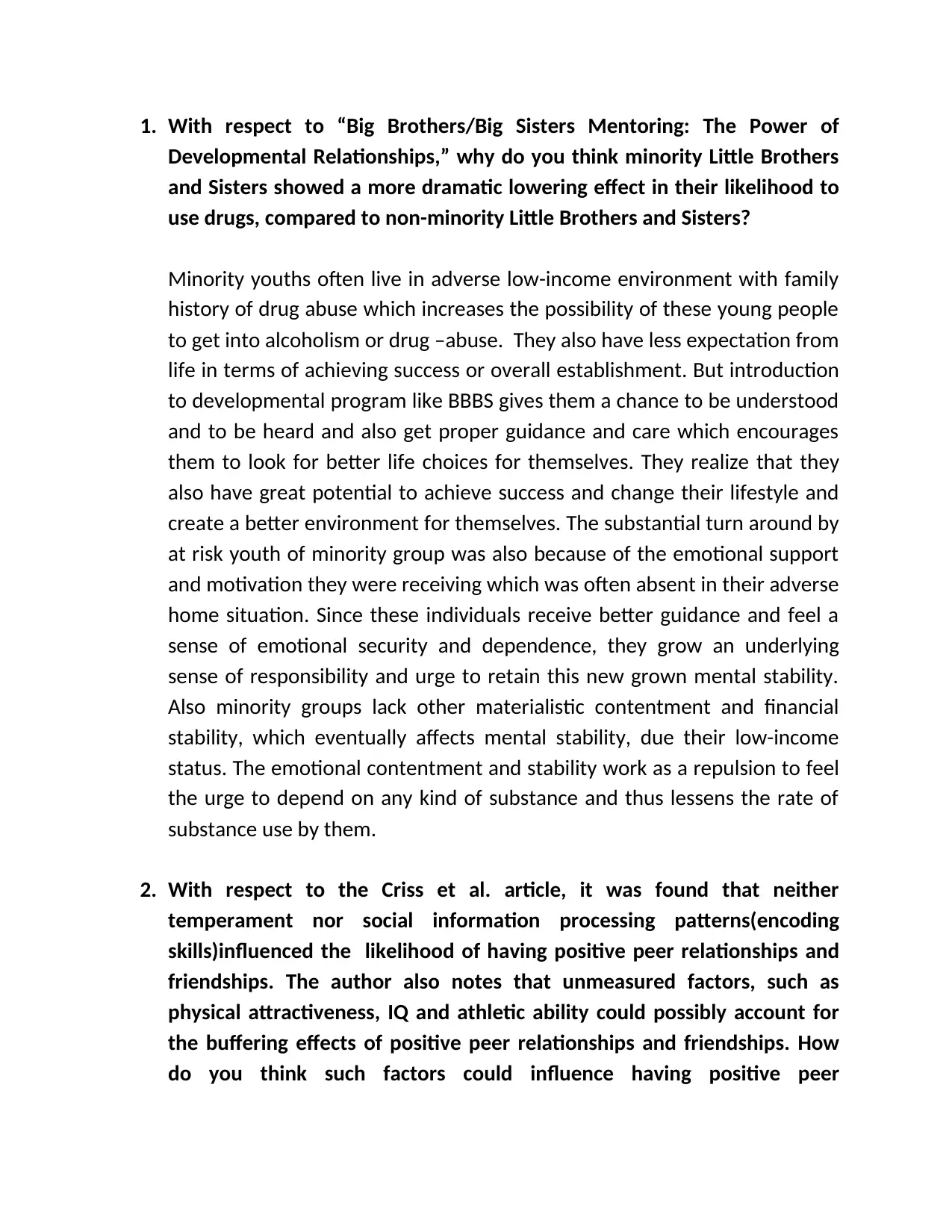
1. With respect to “Big Brothers/Big Sisters Mentoring: The Power of
Developmental Relationships,” why do you think minority Little Brothers
and Sisters showed a more dramatic lowering effect in their likelihood to
use drugs, compared to non-minority Little Brothers and Sisters?
Minority youths often live in adverse low-income environment with family
history of drug abuse which increases the possibility of these young people
to get into alcoholism or drug –abuse. They also have less expectation from
life in terms of achieving success or overall establishment. But introduction
to developmental program like BBBS gives them a chance to be understood
and to be heard and also get proper guidance and care which encourages
them to look for better life choices for themselves. They realize that they
also have great potential to achieve success and change their lifestyle and
create a better environment for themselves. The substantial turn around by
at risk youth of minority group was also because of the emotional support
and motivation they were receiving which was often absent in their adverse
home situation. Since these individuals receive better guidance and feel a
sense of emotional security and dependence, they grow an underlying
sense of responsibility and urge to retain this new grown mental stability.
Also minority groups lack other materialistic contentment and financial
stability, which eventually affects mental stability, due their low-income
status. The emotional contentment and stability work as a repulsion to feel
the urge to depend on any kind of substance and thus lessens the rate of
substance use by them.
2. With respect to the Criss et al. article, it was found that neither
temperament nor social information processing patterns(encoding
skills)influenced the likelihood of having positive peer relationships and
friendships. The author also notes that unmeasured factors, such as
physical attractiveness, IQ and athletic ability could possibly account for
the buffering effects of positive peer relationships and friendships. How
do you think such factors could influence having positive peer
Developmental Relationships,” why do you think minority Little Brothers
and Sisters showed a more dramatic lowering effect in their likelihood to
use drugs, compared to non-minority Little Brothers and Sisters?
Minority youths often live in adverse low-income environment with family
history of drug abuse which increases the possibility of these young people
to get into alcoholism or drug –abuse. They also have less expectation from
life in terms of achieving success or overall establishment. But introduction
to developmental program like BBBS gives them a chance to be understood
and to be heard and also get proper guidance and care which encourages
them to look for better life choices for themselves. They realize that they
also have great potential to achieve success and change their lifestyle and
create a better environment for themselves. The substantial turn around by
at risk youth of minority group was also because of the emotional support
and motivation they were receiving which was often absent in their adverse
home situation. Since these individuals receive better guidance and feel a
sense of emotional security and dependence, they grow an underlying
sense of responsibility and urge to retain this new grown mental stability.
Also minority groups lack other materialistic contentment and financial
stability, which eventually affects mental stability, due their low-income
status. The emotional contentment and stability work as a repulsion to feel
the urge to depend on any kind of substance and thus lessens the rate of
substance use by them.
2. With respect to the Criss et al. article, it was found that neither
temperament nor social information processing patterns(encoding
skills)influenced the likelihood of having positive peer relationships and
friendships. The author also notes that unmeasured factors, such as
physical attractiveness, IQ and athletic ability could possibly account for
the buffering effects of positive peer relationships and friendships. How
do you think such factors could influence having positive peer
Paraphrase This Document
Need a fresh take? Get an instant paraphrase of this document with our AI Paraphraser
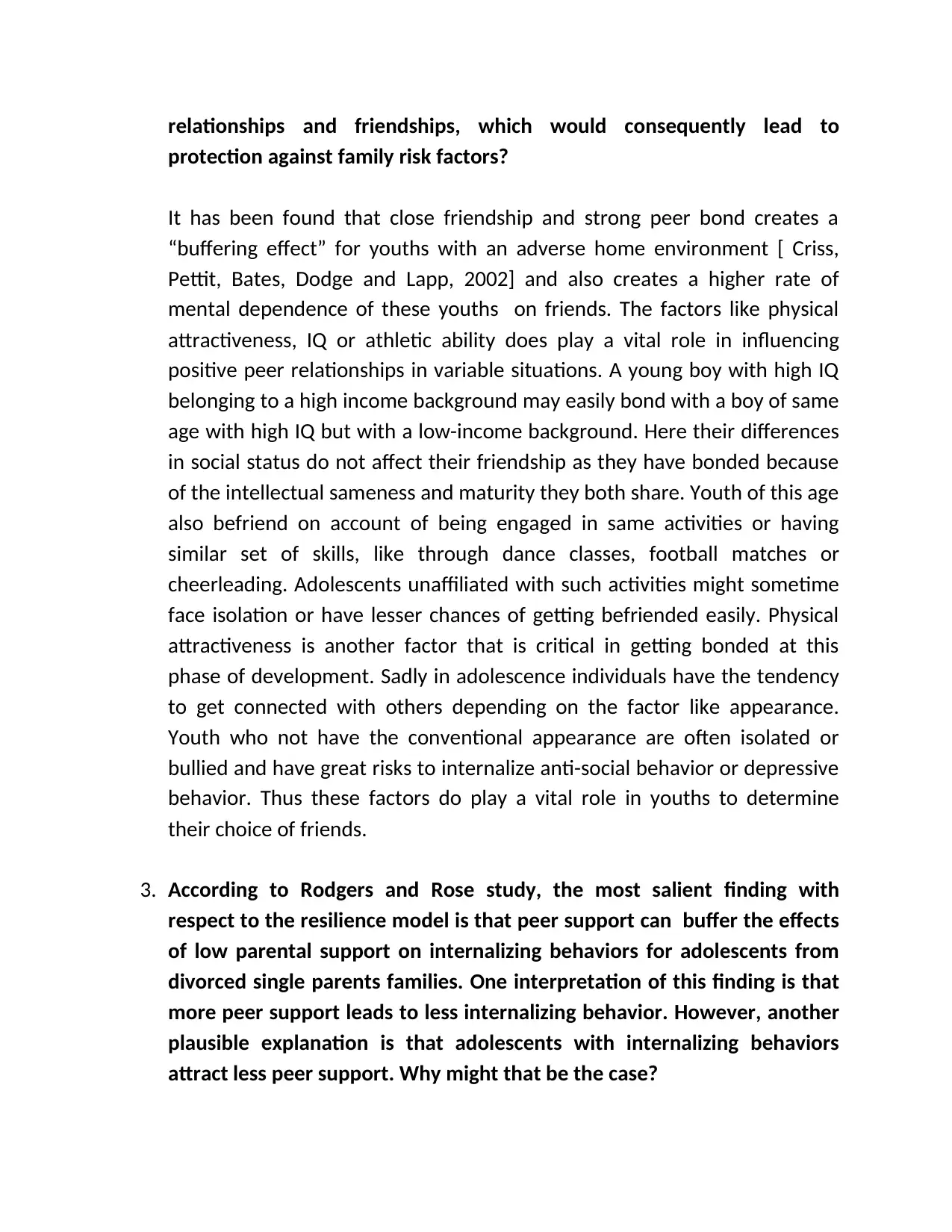
relationships and friendships, which would consequently lead to
protection against family risk factors?
It has been found that close friendship and strong peer bond creates a
“buffering effect” for youths with an adverse home environment [ Criss,
Pettit, Bates, Dodge and Lapp, 2002] and also creates a higher rate of
mental dependence of these youths on friends. The factors like physical
attractiveness, IQ or athletic ability does play a vital role in influencing
positive peer relationships in variable situations. A young boy with high IQ
belonging to a high income background may easily bond with a boy of same
age with high IQ but with a low-income background. Here their differences
in social status do not affect their friendship as they have bonded because
of the intellectual sameness and maturity they both share. Youth of this age
also befriend on account of being engaged in same activities or having
similar set of skills, like through dance classes, football matches or
cheerleading. Adolescents unaffiliated with such activities might sometime
face isolation or have lesser chances of getting befriended easily. Physical
attractiveness is another factor that is critical in getting bonded at this
phase of development. Sadly in adolescence individuals have the tendency
to get connected with others depending on the factor like appearance.
Youth who not have the conventional appearance are often isolated or
bullied and have great risks to internalize anti-social behavior or depressive
behavior. Thus these factors do play a vital role in youths to determine
their choice of friends.
3. According to Rodgers and Rose study, the most salient finding with
respect to the resilience model is that peer support can buffer the effects
of low parental support on internalizing behaviors for adolescents from
divorced single parents families. One interpretation of this finding is that
more peer support leads to less internalizing behavior. However, another
plausible explanation is that adolescents with internalizing behaviors
attract less peer support. Why might that be the case?
protection against family risk factors?
It has been found that close friendship and strong peer bond creates a
“buffering effect” for youths with an adverse home environment [ Criss,
Pettit, Bates, Dodge and Lapp, 2002] and also creates a higher rate of
mental dependence of these youths on friends. The factors like physical
attractiveness, IQ or athletic ability does play a vital role in influencing
positive peer relationships in variable situations. A young boy with high IQ
belonging to a high income background may easily bond with a boy of same
age with high IQ but with a low-income background. Here their differences
in social status do not affect their friendship as they have bonded because
of the intellectual sameness and maturity they both share. Youth of this age
also befriend on account of being engaged in same activities or having
similar set of skills, like through dance classes, football matches or
cheerleading. Adolescents unaffiliated with such activities might sometime
face isolation or have lesser chances of getting befriended easily. Physical
attractiveness is another factor that is critical in getting bonded at this
phase of development. Sadly in adolescence individuals have the tendency
to get connected with others depending on the factor like appearance.
Youth who not have the conventional appearance are often isolated or
bullied and have great risks to internalize anti-social behavior or depressive
behavior. Thus these factors do play a vital role in youths to determine
their choice of friends.
3. According to Rodgers and Rose study, the most salient finding with
respect to the resilience model is that peer support can buffer the effects
of low parental support on internalizing behaviors for adolescents from
divorced single parents families. One interpretation of this finding is that
more peer support leads to less internalizing behavior. However, another
plausible explanation is that adolescents with internalizing behaviors
attract less peer support. Why might that be the case?
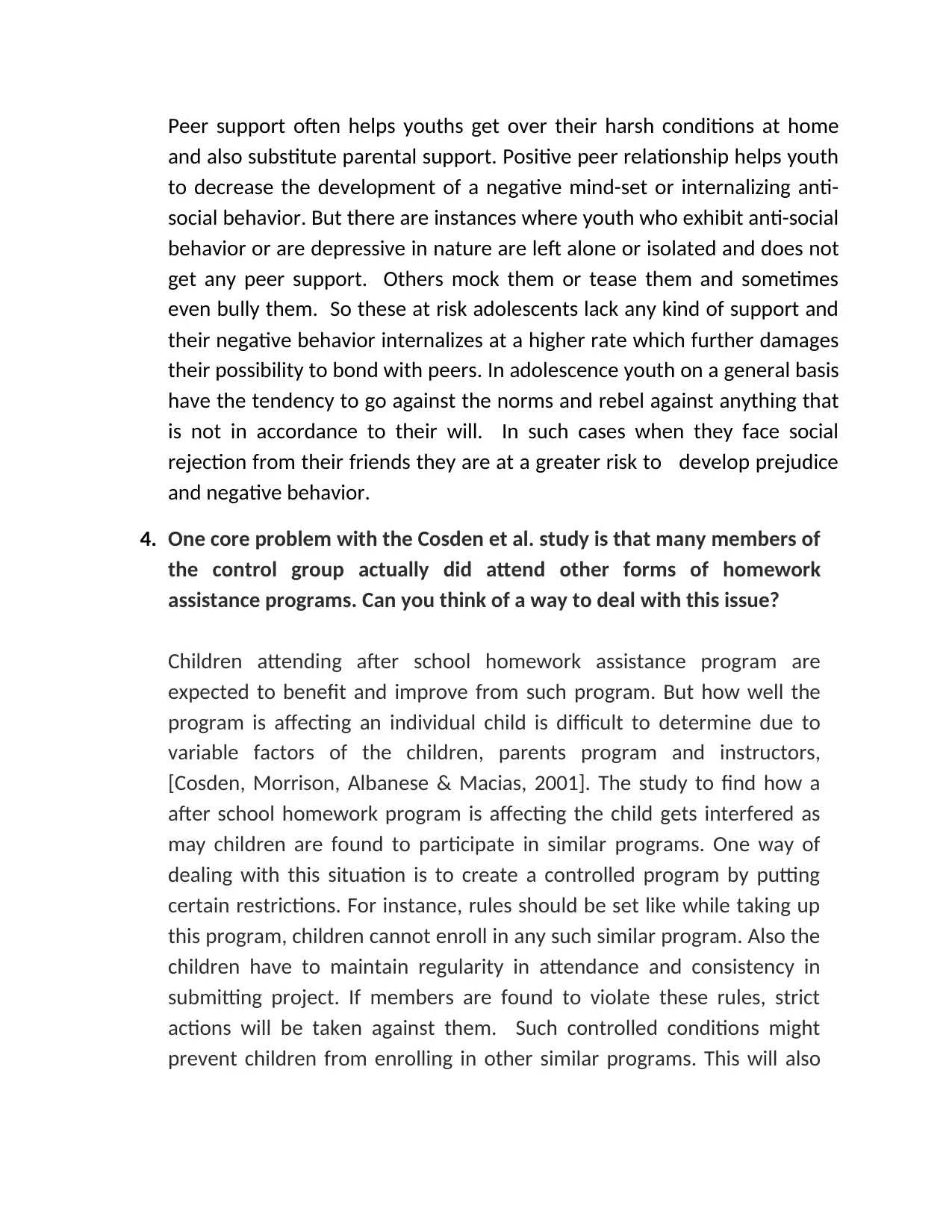
Peer support often helps youths get over their harsh conditions at home
and also substitute parental support. Positive peer relationship helps youth
to decrease the development of a negative mind-set or internalizing anti-
social behavior. But there are instances where youth who exhibit anti-social
behavior or are depressive in nature are left alone or isolated and does not
get any peer support. Others mock them or tease them and sometimes
even bully them. So these at risk adolescents lack any kind of support and
their negative behavior internalizes at a higher rate which further damages
their possibility to bond with peers. In adolescence youth on a general basis
have the tendency to go against the norms and rebel against anything that
is not in accordance to their will. In such cases when they face social
rejection from their friends they are at a greater risk to develop prejudice
and negative behavior.
4. One core problem with the Cosden et al. study is that many members of
the control group actually did attend other forms of homework
assistance programs. Can you think of a way to deal with this issue?
Children attending after school homework assistance program are
expected to benefit and improve from such program. But how well the
program is affecting an individual child is difficult to determine due to
variable factors of the children, parents program and instructors,
[Cosden, Morrison, Albanese & Macias, 2001]. The study to find how a
after school homework program is affecting the child gets interfered as
may children are found to participate in similar programs. One way of
dealing with this situation is to create a controlled program by putting
certain restrictions. For instance, rules should be set like while taking up
this program, children cannot enroll in any such similar program. Also the
children have to maintain regularity in attendance and consistency in
submitting project. If members are found to violate these rules, strict
actions will be taken against them. Such controlled conditions might
prevent children from enrolling in other similar programs. This will also
and also substitute parental support. Positive peer relationship helps youth
to decrease the development of a negative mind-set or internalizing anti-
social behavior. But there are instances where youth who exhibit anti-social
behavior or are depressive in nature are left alone or isolated and does not
get any peer support. Others mock them or tease them and sometimes
even bully them. So these at risk adolescents lack any kind of support and
their negative behavior internalizes at a higher rate which further damages
their possibility to bond with peers. In adolescence youth on a general basis
have the tendency to go against the norms and rebel against anything that
is not in accordance to their will. In such cases when they face social
rejection from their friends they are at a greater risk to develop prejudice
and negative behavior.
4. One core problem with the Cosden et al. study is that many members of
the control group actually did attend other forms of homework
assistance programs. Can you think of a way to deal with this issue?
Children attending after school homework assistance program are
expected to benefit and improve from such program. But how well the
program is affecting an individual child is difficult to determine due to
variable factors of the children, parents program and instructors,
[Cosden, Morrison, Albanese & Macias, 2001]. The study to find how a
after school homework program is affecting the child gets interfered as
may children are found to participate in similar programs. One way of
dealing with this situation is to create a controlled program by putting
certain restrictions. For instance, rules should be set like while taking up
this program, children cannot enroll in any such similar program. Also the
children have to maintain regularity in attendance and consistency in
submitting project. If members are found to violate these rules, strict
actions will be taken against them. Such controlled conditions might
prevent children from enrolling in other similar programs. This will also
⊘ This is a preview!⊘
Do you want full access?
Subscribe today to unlock all pages.

Trusted by 1+ million students worldwide
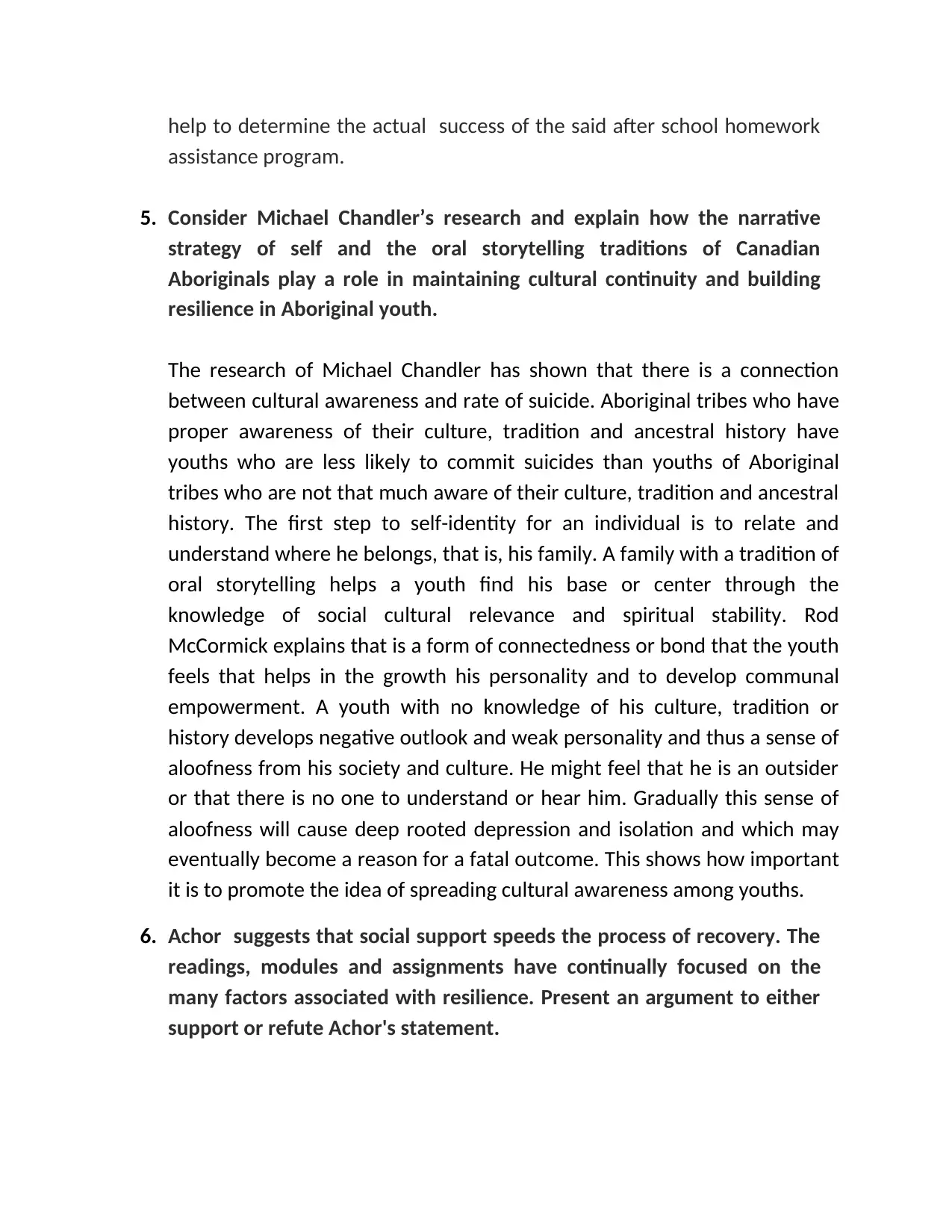
help to determine the actual success of the said after school homework
assistance program.
5. Consider Michael Chandler’s research and explain how the narrative
strategy of self and the oral storytelling traditions of Canadian
Aboriginals play a role in maintaining cultural continuity and building
resilience in Aboriginal youth.
The research of Michael Chandler has shown that there is a connection
between cultural awareness and rate of suicide. Aboriginal tribes who have
proper awareness of their culture, tradition and ancestral history have
youths who are less likely to commit suicides than youths of Aboriginal
tribes who are not that much aware of their culture, tradition and ancestral
history. The first step to self-identity for an individual is to relate and
understand where he belongs, that is, his family. A family with a tradition of
oral storytelling helps a youth find his base or center through the
knowledge of social cultural relevance and spiritual stability. Rod
McCormick explains that is a form of connectedness or bond that the youth
feels that helps in the growth his personality and to develop communal
empowerment. A youth with no knowledge of his culture, tradition or
history develops negative outlook and weak personality and thus a sense of
aloofness from his society and culture. He might feel that he is an outsider
or that there is no one to understand or hear him. Gradually this sense of
aloofness will cause deep rooted depression and isolation and which may
eventually become a reason for a fatal outcome. This shows how important
it is to promote the idea of spreading cultural awareness among youths.
6. Achor suggests that social support speeds the process of recovery. The
readings, modules and assignments have continually focused on the
many factors associated with resilience. Present an argument to either
support or refute Achor's statement.
assistance program.
5. Consider Michael Chandler’s research and explain how the narrative
strategy of self and the oral storytelling traditions of Canadian
Aboriginals play a role in maintaining cultural continuity and building
resilience in Aboriginal youth.
The research of Michael Chandler has shown that there is a connection
between cultural awareness and rate of suicide. Aboriginal tribes who have
proper awareness of their culture, tradition and ancestral history have
youths who are less likely to commit suicides than youths of Aboriginal
tribes who are not that much aware of their culture, tradition and ancestral
history. The first step to self-identity for an individual is to relate and
understand where he belongs, that is, his family. A family with a tradition of
oral storytelling helps a youth find his base or center through the
knowledge of social cultural relevance and spiritual stability. Rod
McCormick explains that is a form of connectedness or bond that the youth
feels that helps in the growth his personality and to develop communal
empowerment. A youth with no knowledge of his culture, tradition or
history develops negative outlook and weak personality and thus a sense of
aloofness from his society and culture. He might feel that he is an outsider
or that there is no one to understand or hear him. Gradually this sense of
aloofness will cause deep rooted depression and isolation and which may
eventually become a reason for a fatal outcome. This shows how important
it is to promote the idea of spreading cultural awareness among youths.
6. Achor suggests that social support speeds the process of recovery. The
readings, modules and assignments have continually focused on the
many factors associated with resilience. Present an argument to either
support or refute Achor's statement.
Paraphrase This Document
Need a fresh take? Get an instant paraphrase of this document with our AI Paraphraser
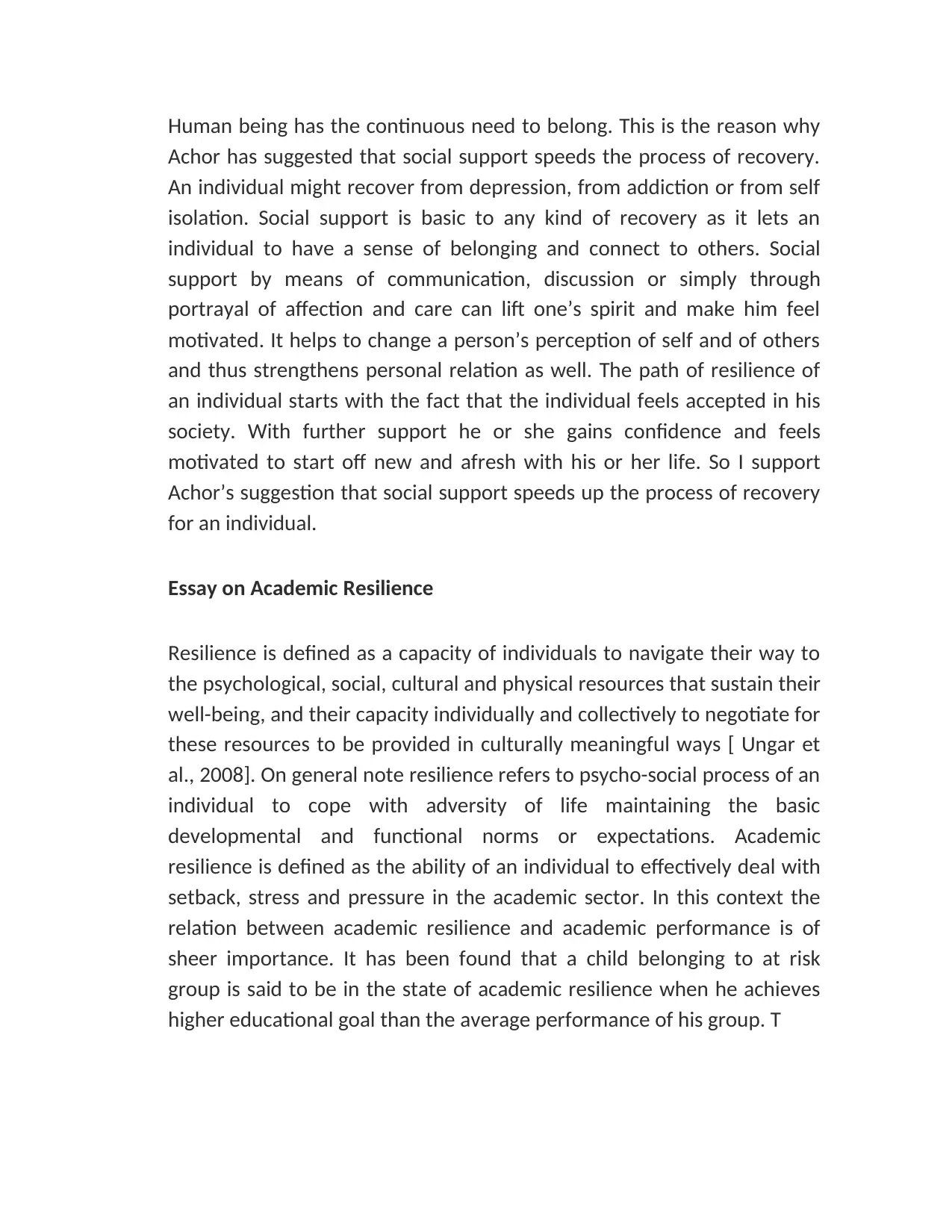
Human being has the continuous need to belong. This is the reason why
Achor has suggested that social support speeds the process of recovery.
An individual might recover from depression, from addiction or from self
isolation. Social support is basic to any kind of recovery as it lets an
individual to have a sense of belonging and connect to others. Social
support by means of communication, discussion or simply through
portrayal of affection and care can lift one’s spirit and make him feel
motivated. It helps to change a person’s perception of self and of others
and thus strengthens personal relation as well. The path of resilience of
an individual starts with the fact that the individual feels accepted in his
society. With further support he or she gains confidence and feels
motivated to start off new and afresh with his or her life. So I support
Achor’s suggestion that social support speeds up the process of recovery
for an individual.
Essay on Academic Resilience
Resilience is defined as a capacity of individuals to navigate their way to
the psychological, social, cultural and physical resources that sustain their
well-being, and their capacity individually and collectively to negotiate for
these resources to be provided in culturally meaningful ways [ Ungar et
al., 2008]. On general note resilience refers to psycho-social process of an
individual to cope with adversity of life maintaining the basic
developmental and functional norms or expectations. Academic
resilience is defined as the ability of an individual to effectively deal with
setback, stress and pressure in the academic sector. In this context the
relation between academic resilience and academic performance is of
sheer importance. It has been found that a child belonging to at risk
group is said to be in the state of academic resilience when he achieves
higher educational goal than the average performance of his group. T
Achor has suggested that social support speeds the process of recovery.
An individual might recover from depression, from addiction or from self
isolation. Social support is basic to any kind of recovery as it lets an
individual to have a sense of belonging and connect to others. Social
support by means of communication, discussion or simply through
portrayal of affection and care can lift one’s spirit and make him feel
motivated. It helps to change a person’s perception of self and of others
and thus strengthens personal relation as well. The path of resilience of
an individual starts with the fact that the individual feels accepted in his
society. With further support he or she gains confidence and feels
motivated to start off new and afresh with his or her life. So I support
Achor’s suggestion that social support speeds up the process of recovery
for an individual.
Essay on Academic Resilience
Resilience is defined as a capacity of individuals to navigate their way to
the psychological, social, cultural and physical resources that sustain their
well-being, and their capacity individually and collectively to negotiate for
these resources to be provided in culturally meaningful ways [ Ungar et
al., 2008]. On general note resilience refers to psycho-social process of an
individual to cope with adversity of life maintaining the basic
developmental and functional norms or expectations. Academic
resilience is defined as the ability of an individual to effectively deal with
setback, stress and pressure in the academic sector. In this context the
relation between academic resilience and academic performance is of
sheer importance. It has been found that a child belonging to at risk
group is said to be in the state of academic resilience when he achieves
higher educational goal than the average performance of his group. T
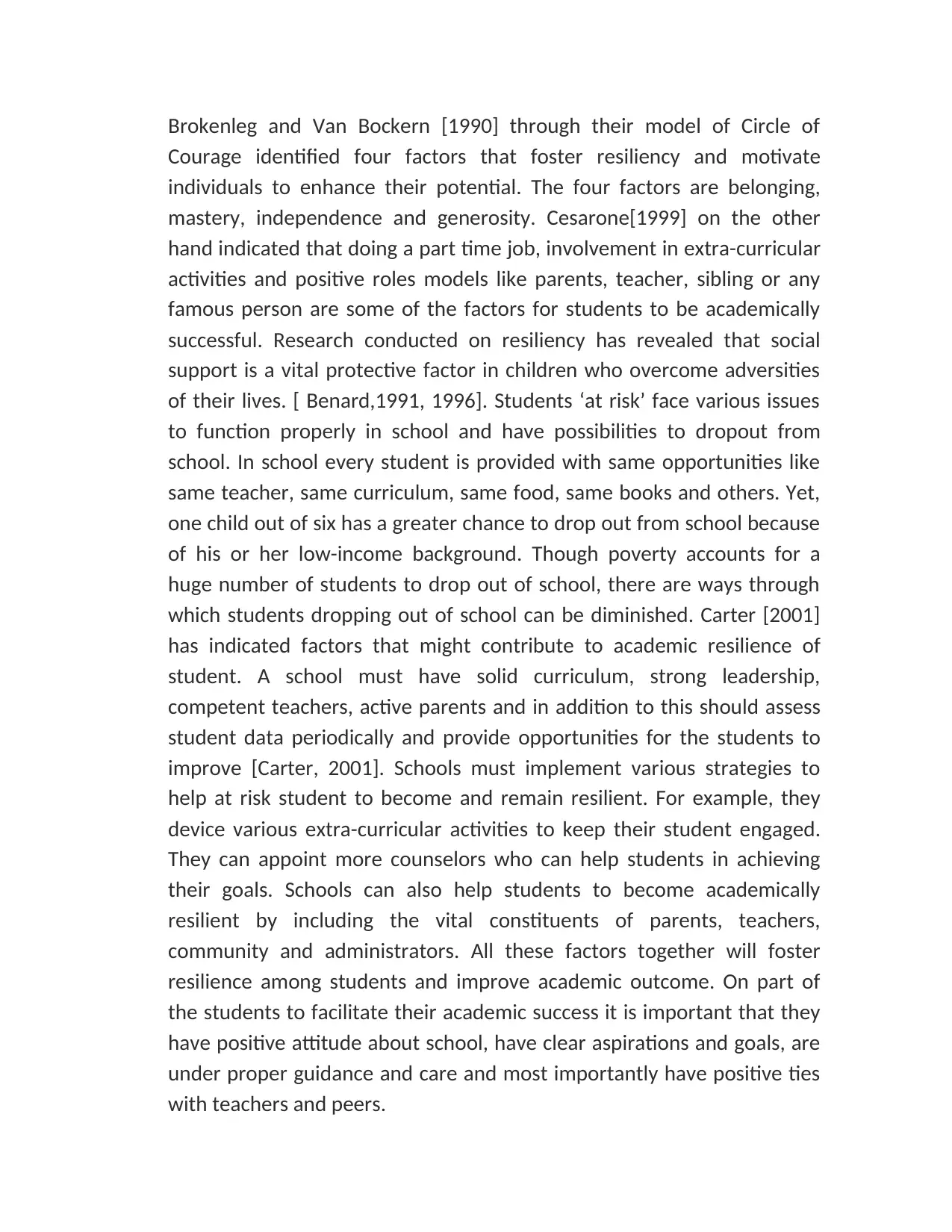
Brokenleg and Van Bockern [1990] through their model of Circle of
Courage identified four factors that foster resiliency and motivate
individuals to enhance their potential. The four factors are belonging,
mastery, independence and generosity. Cesarone[1999] on the other
hand indicated that doing a part time job, involvement in extra-curricular
activities and positive roles models like parents, teacher, sibling or any
famous person are some of the factors for students to be academically
successful. Research conducted on resiliency has revealed that social
support is a vital protective factor in children who overcome adversities
of their lives. [ Benard,1991, 1996]. Students ‘at risk’ face various issues
to function properly in school and have possibilities to dropout from
school. In school every student is provided with same opportunities like
same teacher, same curriculum, same food, same books and others. Yet,
one child out of six has a greater chance to drop out from school because
of his or her low-income background. Though poverty accounts for a
huge number of students to drop out of school, there are ways through
which students dropping out of school can be diminished. Carter [2001]
has indicated factors that might contribute to academic resilience of
student. A school must have solid curriculum, strong leadership,
competent teachers, active parents and in addition to this should assess
student data periodically and provide opportunities for the students to
improve [Carter, 2001]. Schools must implement various strategies to
help at risk student to become and remain resilient. For example, they
device various extra-curricular activities to keep their student engaged.
They can appoint more counselors who can help students in achieving
their goals. Schools can also help students to become academically
resilient by including the vital constituents of parents, teachers,
community and administrators. All these factors together will foster
resilience among students and improve academic outcome. On part of
the students to facilitate their academic success it is important that they
have positive attitude about school, have clear aspirations and goals, are
under proper guidance and care and most importantly have positive ties
with teachers and peers.
Courage identified four factors that foster resiliency and motivate
individuals to enhance their potential. The four factors are belonging,
mastery, independence and generosity. Cesarone[1999] on the other
hand indicated that doing a part time job, involvement in extra-curricular
activities and positive roles models like parents, teacher, sibling or any
famous person are some of the factors for students to be academically
successful. Research conducted on resiliency has revealed that social
support is a vital protective factor in children who overcome adversities
of their lives. [ Benard,1991, 1996]. Students ‘at risk’ face various issues
to function properly in school and have possibilities to dropout from
school. In school every student is provided with same opportunities like
same teacher, same curriculum, same food, same books and others. Yet,
one child out of six has a greater chance to drop out from school because
of his or her low-income background. Though poverty accounts for a
huge number of students to drop out of school, there are ways through
which students dropping out of school can be diminished. Carter [2001]
has indicated factors that might contribute to academic resilience of
student. A school must have solid curriculum, strong leadership,
competent teachers, active parents and in addition to this should assess
student data periodically and provide opportunities for the students to
improve [Carter, 2001]. Schools must implement various strategies to
help at risk student to become and remain resilient. For example, they
device various extra-curricular activities to keep their student engaged.
They can appoint more counselors who can help students in achieving
their goals. Schools can also help students to become academically
resilient by including the vital constituents of parents, teachers,
community and administrators. All these factors together will foster
resilience among students and improve academic outcome. On part of
the students to facilitate their academic success it is important that they
have positive attitude about school, have clear aspirations and goals, are
under proper guidance and care and most importantly have positive ties
with teachers and peers.
⊘ This is a preview!⊘
Do you want full access?
Subscribe today to unlock all pages.

Trusted by 1+ million students worldwide
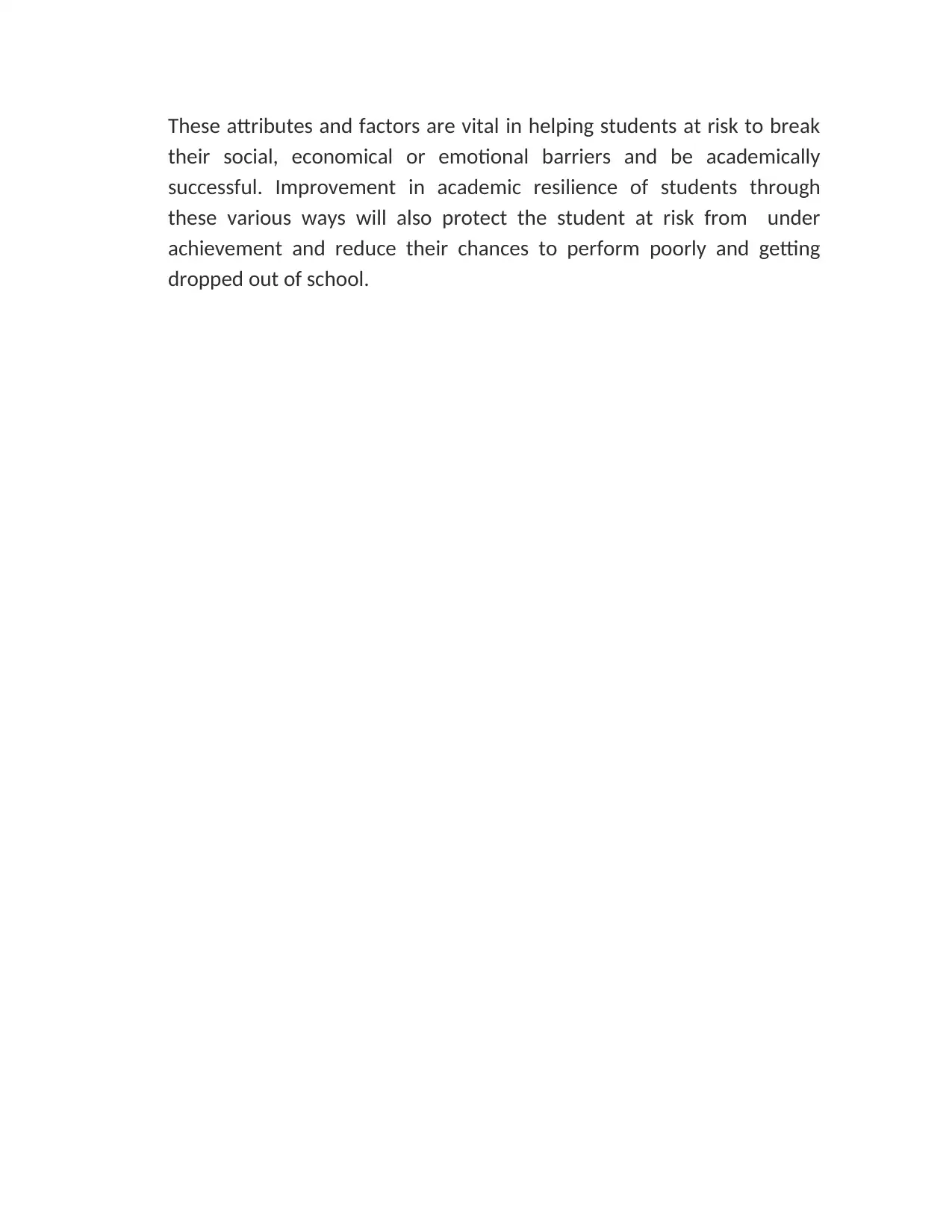
These attributes and factors are vital in helping students at risk to break
their social, economical or emotional barriers and be academically
successful. Improvement in academic resilience of students through
these various ways will also protect the student at risk from under
achievement and reduce their chances to perform poorly and getting
dropped out of school.
their social, economical or emotional barriers and be academically
successful. Improvement in academic resilience of students through
these various ways will also protect the student at risk from under
achievement and reduce their chances to perform poorly and getting
dropped out of school.
1 out of 7
Your All-in-One AI-Powered Toolkit for Academic Success.
+13062052269
info@desklib.com
Available 24*7 on WhatsApp / Email
![[object Object]](/_next/static/media/star-bottom.7253800d.svg)
Unlock your academic potential
Copyright © 2020–2025 A2Z Services. All Rights Reserved. Developed and managed by ZUCOL.